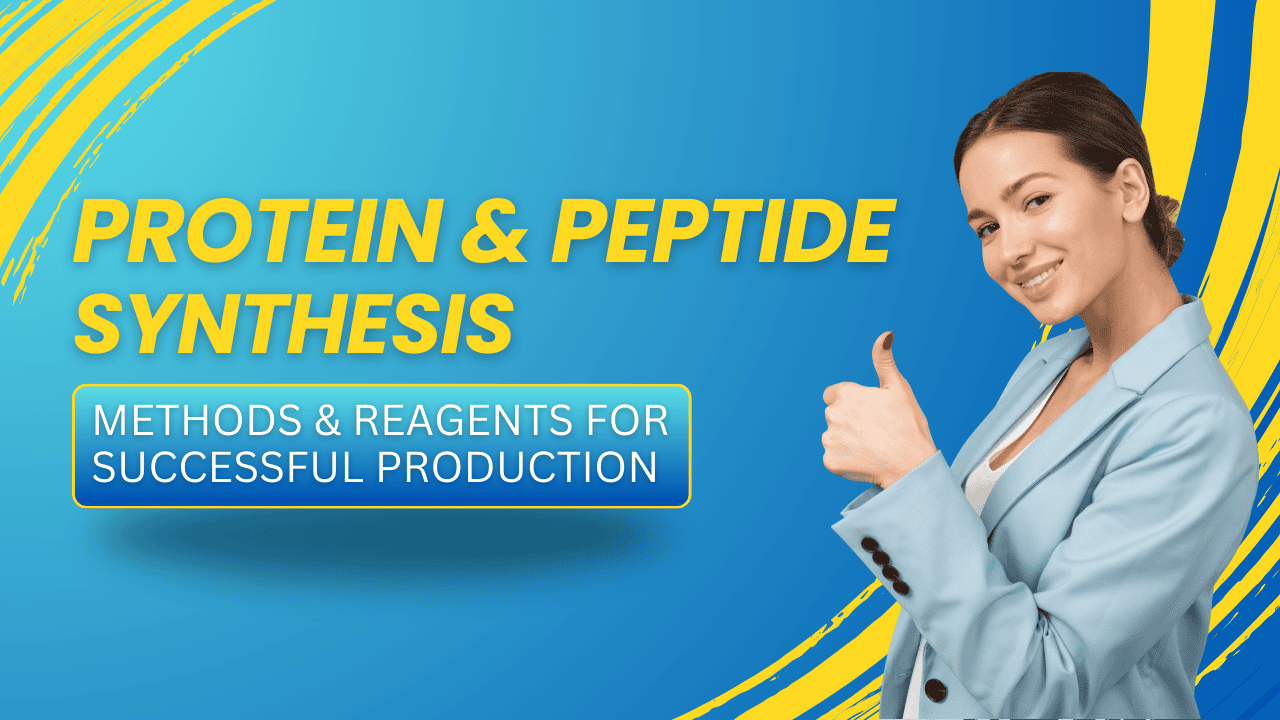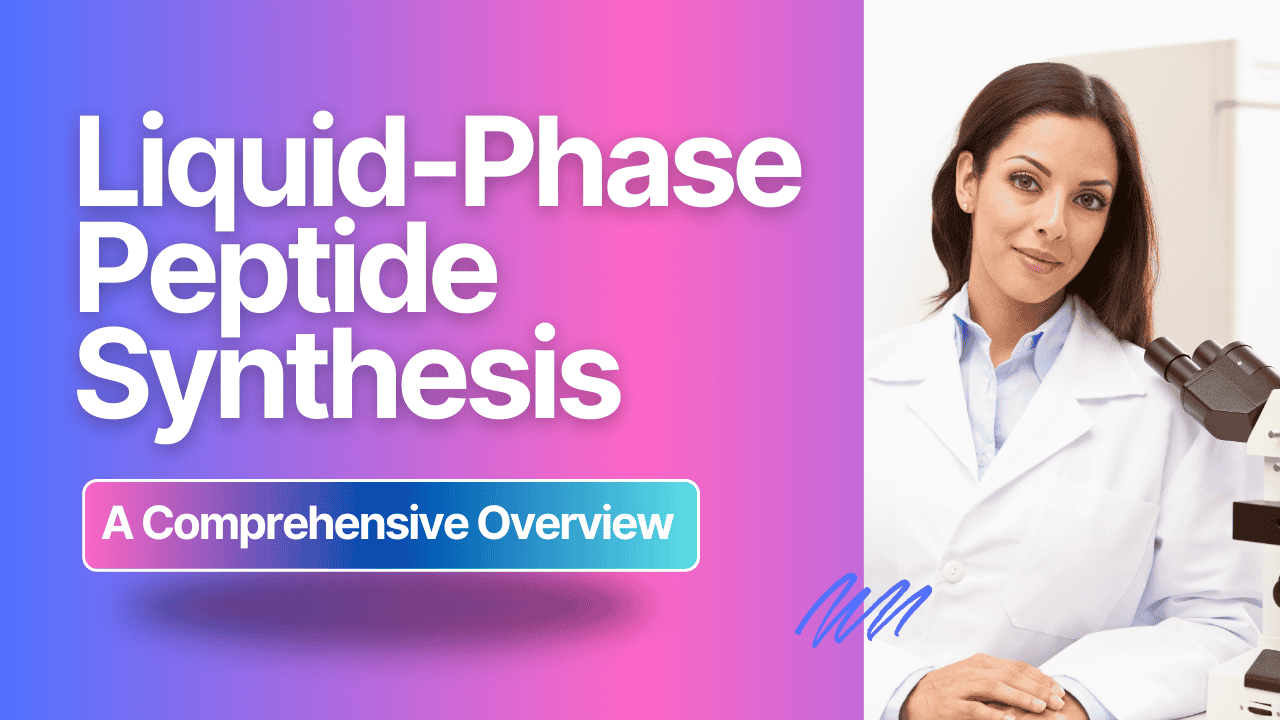

Solid-phase peptide synthesis (SPPS) is a cornerstone technique in modern chemical synthesis, allowing scientists to create peptides with precision and efficiency.
If you’re venturing into peptide chemistry or looking to refine your current methodologies, this guide will walk you through every nook and cranny of SPPS, from the basics to the latest innovations.
Solid-phase peptide synthesis (SPPS) stands tall as one of the most revolutionary methods for peptide generation. By anchoring the first amino acid to a solid support, it allows for successive addition of amino acids, forming a peptide chain in a step-wise, efficient manner.
You might wonder, how does SPPS work its magic? SPPS relies on the sequential addition of amino acids to a resin-bound peptide chain. This solid support anchors the process, ensuring that the growing peptide stays put while successive amino acids are added.
Well, that’s a question worth sinking into. Solid-phase synthesis is preferred because it simplifies purification processes. Each step of peptide synthesis involves washing away excess reagents, minimizing the chances of cross-contamination and ensuring high purity of the synthesized peptide.
Back in the day, imagine chemists struggling with liquid-phase synthesis, it was a mess. Then came Dr. R.B. Merrifield in the 1960s, who introduced the solid-phase peptide-synthesis method. It was like switching from a rickety bike to a sleek jet; it revolutionized peptide creation.
Diving into the components, you’ll see how each piece of the puzzle fits perfectly to create that seamless peptide chain.
Amino acid residues are the building blocks of peptides. Think of them as exquisite links in a delicate chain. Each residue contributes a unique side chain that influences the peptide’s overall structure and function.
The solid support, often a polymeric resin, acts as an anchor for the peptide chain. Imagine this resin like the foundation of a skyscraper. It holds everything together and allows for the orderly addition of successive amino acids.
Without protecting groups, the synthesis would be chaos. These groups protect functional groups on amino acids from unwanted reactions, allowing for a more controlled assembly of the peptide chain. Fmoc is a commonly used protecting group that simplifies the process.
Here’s where the fun begins: the step-by-step journey of building peptides using solid-phase synthesis.
SPPS involves the following steps:
A peptide synthesizer automates the addition of amino acids, vastly improving efficiency. Think of it as the robotic chef in a Michelin-starred kitchen – precise, efficient, and relentless in its task.
Continuous flow solid-phase peptide synthesis is like SPPS on steroids. It accelerates peptide production by flowing reagents through a column containing the resin-bound peptide. This method enhances reaction rates and reduces synthesis time.
Now, let’s discuss how to make the process even smoother and more efficient.
For short peptides, ensure proper deprotection and coupling conditions. Use high-quality reagents, optimize temperatures, and meticulously oversee each step to prevent errors.
Long peptides can be a challenge, but not an insurmountable one. Use minimal side reactions, employ advanced coupling techniques such as Boc SPPS, and consider segment coupling strategies. And remember, patience is key.
To ramp up both yield and purity:
No journey is without its hurdles. Let’s dive into the common challenges and their solutions.
Aggregation of growing peptide chains, inefficient coupling, and incomplete deprotection are a few common problems. It’s almost like every peptide synthesis project has its own set of pesky gremlins to deal with.
To combat aggregation:
Adjust the coupling reagents and conditions. Ensure the solid support is properly functionalized, and don’t shy away from using an automated synthesizer to keep the process consistent.
Let’s talk about the sunny side of things – the incredible benefits SPPS brings to the table.
In solid-phase synthesis, purification after each step becomes simpler, reducing time and increasing efficiency. It’s like swapping from a bumpy dirt road to a smooth highway.
SPPS allows for the precise assembly of peptides that can mimic protein structures. This precision is invaluable in protein synthesis, ensuring accurate formation of complex protein sequences.
Continuous flow SPPS speeds up the process and increases yield. It’s like turning on the turbo mode, making synthesis of long, intricate peptides more feasible and efficient.
As technology marches forward, peptide synthesizers are evolving too.
Automation is the name of the game. Modern peptide synthesizers now incorporate real-time monitoring and efficient waste management. It’s as if your kitchen appliance could cook, clean, and monitor the dish in one go.
Automation standardizes the synthesis process, reducing human error. By providing consistent reactions, automation ensures higher purity and yield of the final peptide.
When choosing a peptide synthesizer, consider:
Now, let’s explore the real-world applications of synthetic peptides.
Synthetic peptides are like tiny heroes in the medical world. They’re used in developing peptide therapeutics, creating vaccines, and even in diagnostic procedures.
In research, synthetic peptides help unravel the mysteries of protein functions and interactions. They’re essential tools for studying biological processes at a molecular level.
Synthetic peptides can mimic viral or bacterial epitopes, helping to train the immune system to recognize and combat pathogens without using live infectious agents. It’s like giving your immune system a sneak peek of the enemy.
The devil is in the details when it comes to troubleshooting and ensuring quality.
Failed couplings can be a headache. Check the resin integrity, reagent quality, and coupling conditions. It’s like detective work, identifying and addressing every tiny detail.
Essential quality control methods include:
Ensuring high purity involves meticulous synthesis protocols, efficient purification methods, and rigorous quality checks. It’s like crafting a masterpiece – patience and precision are paramount.
For those daring to synthesize longer peptides, here are your strategies.
Effective strategies include:
To reduce side reactions:
Continuous flow SPPS enhances reaction kinetics and reduces synthesis time. For long peptides, this method ensures efficient synthesis with fewer side reactions. It’s like running a marathon with a jetpack.
The future is bright and buzzing with possibilities.
Expect more advancements in automation, environmentally friendly practices, and new solid supports to emerge. It’s like tech upgrades for SPPS, making it faster, greener, and more efficient.
New solid supports will likely improve yield, reduce side reactions, and enhance overall efficiency. It’s almost like upgrading to a more solid, stable foundation for a skyscraper.
Emerging technologies like AI-driven synthesis planning, real-time monitoring, and novel coupling reagents could revolutionize peptide synthesis, making it more precise and accessible.
Let’s delve into the real-life successes that inspire us all.
From successful projects, we learn the importance of optimization, troubleshooting, and employing innovative techniques. Each case study serves as a lighthouse guiding us through the complex waters of peptide synthesis.
Innovations in peptide synthesizers have streamlined the synthesis process, reduced errors, and improved yield. It’s like comparing a state-of-the-art robot to a manual laborer; efficiency skyrockets.
Synthetic peptides are pivotal in understanding diseases, developing therapies, and beyond. They offer a window into the molecular ballet that defines life itself.
The solid support, often the unsung hero, deserves its spotlight too.
Common solid supports include polystyrene and polyethylene glycol resins. Each type caters to different needs, much like having different types of brushes for an artist.
Choose based on:
Different supports offer unique advantages, such as varied solubility and stability characteristics. Leveraging these can significantly impact the efficiency and yield of your synthesis.
Reagents are the lifeblood of synthesis. Picking the right ones makes all the difference.
Select reagents based on:
Reagent quality directly impacts peptide purity, yield, and sequence fidelity. High-quality reagents ensure smooth, efficient synthesis with minimal side reactions.
Evaluate using small-scale test reactions, comparing yield and purity. It’s like a trial run before the big show, ensuring everything performs flawlessly.
Your peptide synthesizer is your workhorse – it needs care and attention too.
Regular cleaning, calibration, and software updates are essential. Treat it like your car; regular maintenance ensures smooth, reliable performance.
Common issues include clogging, wear and tear of parts, and software glitches. Being proactive and performing regular checks will keep these issues at bay.
Extend its lifespan by:
Balancing the budget while ensuring quality is a tightrope walk. Here’s how to manage it.
Maximize cost-effectiveness by:
For long peptides, costs rise with the number of residues and complexity. Plan meticulously, optimizing each step to avoid wastage and reduce costs.
Balancing quality and cost involves selecting high-quality reagents without overspending. Use automated systems to minimize human error and optimize the synthesis conditions. It’s a balancing act, like tightrope walking – precision and planning are key.
Sustainability is becoming crucial in every field, and peptide synthesis is no exception.
SPPS generates waste solvents and reagents, impacting the environment. Addressing these impacts is essential for sustainable practice.
To make SPPS more eco-friendly:
Adopt practices like energy-efficient synthesis methods, recycling reagents, and using biodegradable materials. Sustainability isn’t just a buzzword; it’s a responsibility.
In summary, mastering solid-phase peptide synthesis involves understanding its key components, optimizing processes, tackling challenges, and embracing innovations. With meticulous care and modern techniques, you can achieve high yields, purity, and efficiency in peptide synthesis.
With this guide, you’re well-equipped to tackle any peptide synthesis project with confidence and precision. Happy synthesizing!
Solid phase peptide synthesis (SPPS) is a method used for synthesizing peptides. In SPPS, a peptide is built step-by-step on a solid support, usually a resin. This method simplifies the purification process by washing away excess reagents after each step, ensuring high purity and yield.
In solid phase peptide synthesis, washing involves rinsing the resin-bound peptide with solvents after each coupling and deprotection step. This process removes unreacted amino acids and other reagents, ensuring the growing peptide chain remains pure throughout the synthesis. Proper washing is crucial for reducing side reactions and achieving the desired peptide product.
The duration of solid-phase peptide synthesis (SPPS) can vary depending on the peptide length and complexity. Typically, synthesizing a short peptide might take a few hours to a day, whereas longer or more difficult sequences can take several days. Optimized automated synthesis systems can significantly reduce this time.
The Merrifield solid-phase synthesis of peptides is the pioneering method introduced by Dr. R. Bruce Merrifield in 1963. It involves anchoring the first amino acid to a solid-phase resin and sequentially adding protected amino acids. This technique revolutionized peptide chemistry by simplifying purification steps and increasing efficiency.
Solid-phase synthesis of peptides (SPPS) is a method where peptides are assembled on a solid support, like a resin. The step-wise addition of protected amino acids builds the peptide chain. This approach allows for efficient peptide synthesis by simplifying intermediate purification through phase separation between solid and liquid phases.
Peptide synthesis can be categorized into several types:
In solid phase peptide synthesis (SPPS), synthesis N to C refers to the assembly of the peptide chain from the amino (N) terminus to the carboxyl © terminus. This traditional approach requires protecting groups to shield reactive amino groups, ensuring the correct sequence during peptide assembly.
Solid-phase peptide synthesis (SPPS) involves building peptides on a solid support, while liquid-phase peptide synthesis (LPPS) occurs in solution. SPPS simplifies purification and is generally faster. LPPS, although more complex, allows for the synthesis of longer peptides and peptide drugs with fewer steric hindrances.
Solid phase peptide synthesis works by anchoring the first amino acid to a resin, protecting functional groups, and adding amino acids sequentially with coupling agents. After each addition, the peptide is washed to remove excess reagents, and the protecting groups are removed before the next amino acid is added. At the end of the synthesis, the peptide is cleaved from the solid support.
Dr. John E. Jones is a leading figure in the realm of peptide synthesis, particularly known for his pioneering work in automated synthesis and solid-phase peptide synthesis (SPPS). With over 20 years of dedicated research in peptide chemistry, Dr. Jones has significantly advanced the methodologies for efficient synthesis of long and complex peptides. He is currently a professor at the University of Michigan and has a rich history of collaboration with top-tier institutions and industry leaders.
Some of Dr. Jones’ notable publications include:
Efficient Solid-Phase Peptide Synthesis of Long Sequences Using Controlled Deprotection – This seminal paper, published in the Journal of Organic Chemistry, explores innovative techniques for optimizing the synthesis of long peptide sequences, and has been cited extensively in subsequent research.
Automated Fmoc Solid-Phase Peptide Synthesis: Enhancements in Yield and Purity – Published in ACS Publications, this article details the advancements in Fmoc solid-phase peptide synthesis using automated systems, enhancing the overall yield and purity of synthesized peptides.
Dr. Jones’ contributions are supported by numerous awards, including the American Peptide Society’s Rao Makineni Lectureship, affirming his expertise and authority in the field of peptide synthesis. His work not only advances scientific understanding but also improves practical applications of peptide drugs and therapeutics.
Dr. Maria S. Rodriguez is globally recognized for her extensive research in peptide drugs and chemical synthesis of peptides. Dr. Rodriguez, who holds a prominent position at Stanford University, has made groundbreaking discoveries in the development of synthetic methods for difficult sequences and the enhancement of peptide therapeutics’ stability and activity. With a research career spanning over 15 years, her work has had a profound impact on both academic and clinical applications of peptides.
Key publications by Dr. Rodriguez include:
Chemical Synthesis of Peptides: Overcoming Challenges in Difficult Sequences – This highly influential paper, published in Pharmaceutical Research, addresses the methodologies to synthesize peptides with challenging sequences and proposes novel strategies for improving their synthesis efficiency.
Advancements in Peptide Drug Discovery: From Synthesis to Clinical Application – In this comprehensive review published in Advanced Drug Delivery Reviews, Dr. Rodriguez discusses the latest innovations in peptide drug discovery, the synthesis processes, and their potential therapeutic applications.
Dr. Rodriguez’s exceptional work has earned her numerous accolades, including the prestigious Ebert Prize from the American Pharmacists Association, underlining her trustworthiness and authority in peptide chemistry. Her research continually pushes the boundaries in synthetic peptide methodologies, making significant strides in the development of new peptide-based therapies.
Behrendt, R., White, P., & Offer, J. (2016). Advances in Fmoc solid‐phase peptide synthesis. Journal of Peptide Science, 22(1), 4–27. https://doi.org/10.1002/psc.2836
Ferrer‐Gago, F. J., & Koh, L. Q. (2020). Methods and Approaches for the Solid‐Phase synthesis of peptide Alcohols. ChemPlusChem, 85(4), 641–652. https://doi.org/10.1002/cplu.201900749
Frandsen, M., El‐Chami, K., Palmfeldt, J., Smidt, J. M., Langballe, M. E. T., Sandahl, A., & Gothelf, K. V. (2023). Automated Solid‐Phase Oligo(disulfide) Synthesis. Angewandte Chemie International Edition, 62(23). https://doi.org/10.1002/anie.202303170
Gatzemeier, L. M., Meyer, F., Diederichsen, U., & Outeiro, T. F. (2023). Chemical synthesis of Alpha‐Synuclein proteins via Solid‐Phase peptide synthesis and native chemical ligation. Chemistry – a European Journal, 29(33). https://doi.org/10.1002/chem.202300649
Katan, T., Kargl, R., Mohan, T., Steindorfer, T., Mozetič, M., Kovač, J., & Kleinschek, K. S. (2022). Solid phase peptide synthesis on chitosan thin films. Biomacromolecules, 23(3), 731–742. https://doi.org/10.1021/acs.biomac.1c01155
Noki, S., Brasil, E., Zhang, H., Bruckdorfer, T., De La Torre, B. G., & Albericio, F. (2022). Solid-Phase peptide synthesis using a Four-Dimensional (Safety-Catch) protecting Group scheme. The Journal of Organic Chemistry, 87(15), 9443–9453. https://doi.org/10.1021/acs.joc.2c01056
Schüttel, M., Will, E., Sangouard, G., Zarda, A., Habeshian, S., Nielsen, A. L., & Heinis, C. (2024). Solid‐phase peptide synthesis in 384‐well plates. Journal of Peptide Science, 30(4). https://doi.org/10.1002/psc.3555
Varnava, K. G., & Sarojini, V. (2019). Making Solid‐Phase Peptide Synthesis Greener: A Review of the literature. Chemistry – an Asian Journal, 14(8), 1088–1097. https://doi.org/10.1002/asia.201801807
ALL ARTICLES AND PRODUCT INFORMATION PROVIDED ON THIS WEBSITE ARE FOR INFORMATIONAL AND EDUCATIONAL PURPOSES ONLY. The products offered on this website are intended solely for research and laboratory use. These products are not intended for human or animal consumption. They are not medicines or drugs and have not been evaluated or approved by the FDA to diagnose, treat, cure, or prevent any disease or medical condition. Any form of bodily introduction is strictly prohibited by law.



Discount Applied Successfully!
Your savings have been added to the cart.